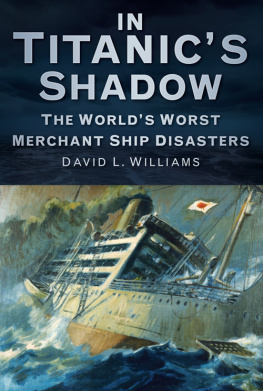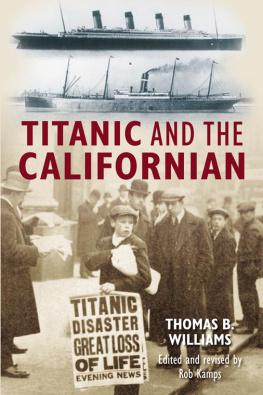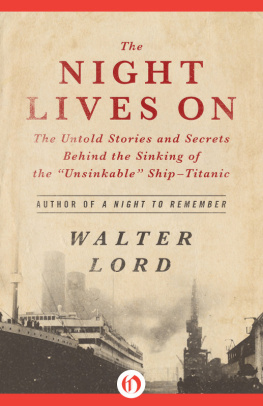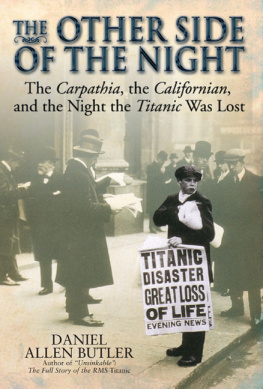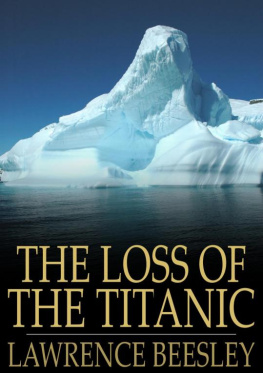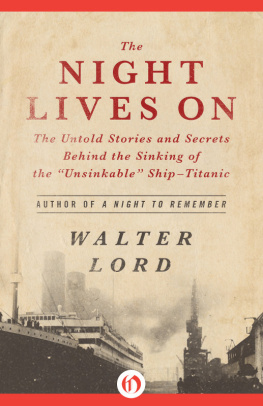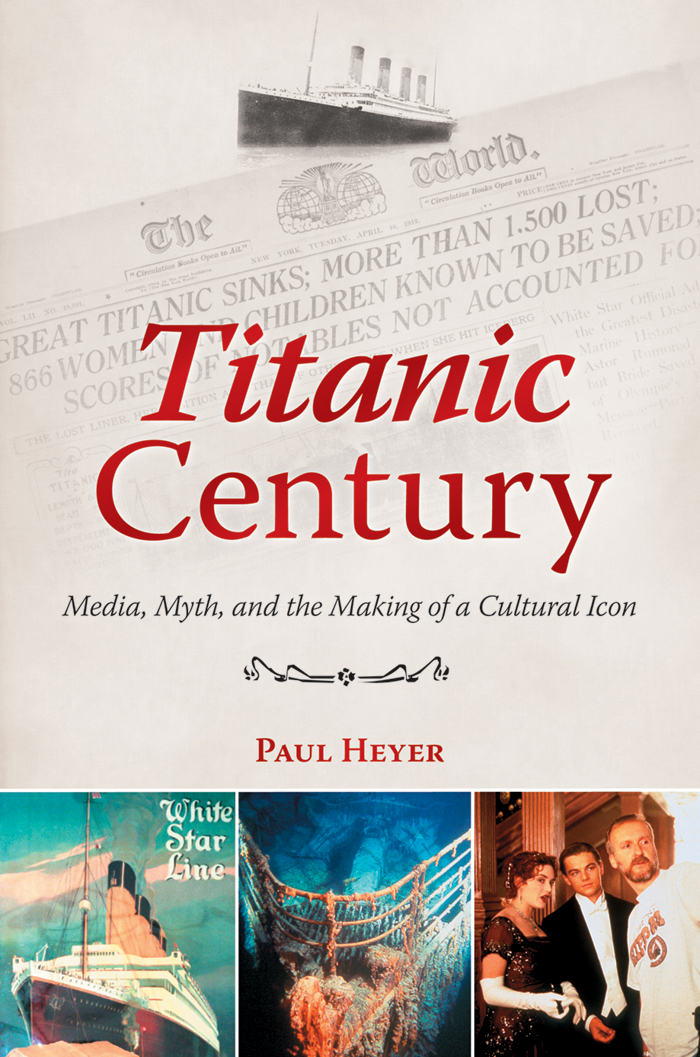Paul Heyer is a media historian teaching in the Department of Communication Studies at Wilfrid Laurier University in Ontario, Canada. His books include Communications and History: Theories of Media, Knowledge, and Civilization (Praeger, 1988), The Medium and the Magician: Orson Welles, the Radio Years (2005), and most recently the sixth edition of Communication in History: Technology, Culture, Society (2010), coedited with David Crowley.
Titanic Century
Media, Myth, and the Making of a Cultural Icon
Paul Heyer
ABC-CLIO, LLC
Copyright 2012 by Paul Heyer
All rights reserved. No part of this publication may be reproduced, stored in a retrieval system, or transmitted, in any form or by any means, electronic, mechanical, photocopying, recording, or otherwise, except for the inclusion of brief quotations in a review, without prior permission in writing from the publisher.
Library of Congress Cataloging-in-Publication Data
Heyer, Paul, 1946
Titanic century : media, myth, and the making of a cultural icon / Paul Heyer.
p. cm.
Includes bibliographical references and index.
ISBN 9780313398155 (hardback) ISBN 9780313398162 (ebook) 1. Titanic (Steamship) 2. ShipwrecksNorth Atlantic Ocean. 3. DisastersPress coverage. I. Title.
G530.T6H48 2012
910.91634dc23 2012000372
ISBN: 978-0-313-39815-5
EISBN: 978-0-313-39816-2
16 15 14 13 12 1 3 2 4 5
This book is also available on the World Wide Web as an eBook.
Visit www.abc-clio.com for details.
Praeger
An Imprint of ABC-CLIO, LLC
ABC-CLIO, LLC
130 Cremona Drive, P.O. Box 1911
Santa Barbara, California 93116-1911
This book is printed on acid-free paper
Manufactured in the United States of America
IMAX is a registered trademark of IMAX Corporation
For Carole
And, behold, I, even I, do bring a flood of waters upon the earth, to destroy all flesh, wherein is the breath of life, from under heaven; and everything that is the earth shall die.
Genesis 6:1
Now small fowls flew screaming over the great yawning gulf; a sullen white surf beat against its steep sides; then all collapsed and the great shroud of the sea rolled on as it rolled five thousand years ago.
Herman Melville, Moby Dick
Contents
Preface
It is now 100 years and counting since that unforgettable night in April of 1912 when the great ship went down and an incredulous world tried to fathom how such an unthinkable tragedy could have happened. In 1995 an earlier edition of this book appeared in response to renewed interest in the sinking resulting from the discovery of the wreck during the previous decade. By the turn of the millennium, however, I thought closure would finally be brought to one of the defining events of the twentieth century. I assumed that the public and the medias almost century-long fascination would have ebbed, finally putting an end to my role as a chronicler of that phenomenon. I should have known better. Much has happened since. I was warned at the time that one of the consequences of any writerly engagement with the Titanic is that she will never let go.
Shortly after my book appeared I followed with interest events leading up to the release of James Camerons Titanic in 1997. I shared the general opinion of film cognoscenti in believing that movies had exhausted the Titanic as a subject and public interest was on the wane. Camerons folly, the film was called in the press. It seemed like another Waterworld or Ishtar waiting to happen, only in this case foreshadowed in the most obvious of ways by the resounding box office failure in the early 1980s of Raise the Titanic. Quite the opposite happened. And in one of those strange quirks of fate I was invited to appear in the film as an extra. Circumstances and caution precluded my acceptance. I was in the middle of a teaching semester and found it hard to justify taking a two-week leave to appear in a film that seemed ill fated, was already running over budget and schedule, and contained no A-list starsKate Winslet and Leonardo DiCaprio were barely known at the time. My screen debut would have to wait until the year following the films release and would be on television, when I was asked to be a consultant and on-camera commentator for the A&E prime-time documentary Beyond Titanic.
Post-2000 events relating to the Titanic started off slowly but have continued to escalate: new theories relating to her demise, the ongoing exhibition of the salvaged artifacts, the re-release of Camerons Titanic in 3D, and the various cruises and commemorative services planned around the centenary of the tragedy. It seems we cannot let the great ship rest in peacenor she us. I began to feel that my obligation as a chronicler of the legacy was not yet fulfilled and that my earlier work was in need of substantial revision if I wanted to account for what has transpired since. At Praeger, a wonderfully encouraging editor, Michael Millman, was of a like mind. Together we mapped out a plan to raise and completely refit, if you will pardon the maritime terminology, the original plan I conceived almost 20 years ago.
My interest in the story of the Titanic, or in terms of this book the story of her stories, derives from an encounter between a childhood fascination inspired by films such as Titanic (1953) and A Night to Remember (1958) and a career writing and teaching in the field of media studies. They converged unexpectedly in the 1980s when I joined countless others in being enthralled by press and television coverage of the search for the wreck. This prompted a desire to research aspects of the disaster, particularly its influence over a variety of communication media and the medias role in immortalizing the event. The book that followed was well received, but by millenniums end I had put it behind me, or so I thought. What happened later can be expressed somewhat by inverting the famous promotional moniker used for Jaws II, just when I thought it was safe to get out of the water.
Many commentaries have been written about the Titanic disaster. Most deal with what happened, why, and all the what ifs that will forever cling to it. My concern here is not to provide another such account nor to overly speculate on the many mysteries surrounding the ships demise, save for what I feel is the greatest one: not why she struck an iceberg on a cold April night once-upon-a-time, but the hold that the event still has over us.
In exploring this question, I examine how the Titanics abortive four-day voyage turned into a 100-year journey in the history of U.S. popular culture and its attendant media. Her fate has prompted endless reflection and influenced established institutions. For example, it showcased the promise and the limitations of the new medium of wireless telegraphy, making Marconi a household name and launching David Sarnoff into a career as head of RCA; it helped raise the stature of the New York Times to the eminence it has today; and for a century it has been represented in and has influenced a variety of media, especially motion pictureswithout the success of James Camerons Titanic, there would have been no Avatar. Finally, I suggest that the cautionary lesson provided by the ships fate has given her story a mythic status comparable to what we find with great works of literature, from the Bible to Shakespeare. At the time she was built the


